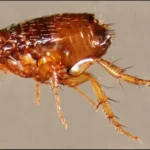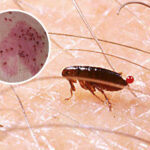Fleas are more than just a nuisance for pets; they can quickly become a persistent problem for homeowners. These tiny, blood-sucking insects are notorious for being incredibly difficult to eradicate, and their presence can cause significant discomfort for both humans and pets. So why are fleas so hard to eliminate from your home? Here, we will explore the reasons behind their persistence and what makes flea infestations so challenging to treat effectively.
1. The Complex Flea Life Cycle
One of the primary reasons fleas are so hard to get rid of is their complex life cycle. Fleas undergo four stages: egg, larva, pupa, and adult. However, it’s not just the adult fleas that are the problem; the entire life cycle contributes to the persistence of the infestation.
- Eggs: Female fleas lay eggs on their host (usually pets), but these eggs fall off onto carpets, bedding, and furniture. Flea eggs are tiny, white, and hard to spot, which makes them easy to miss during cleaning. They can also remain dormant for up to several weeks, waiting for the right conditions (warmth and humidity) to hatch.
- Larvae: Once the eggs hatch, flea larvae feed on organic debris, including the feces of adult fleas, which contain partially digested blood. Larvae thrive in dark, hidden places such as cracks in the floor or under furniture, making them difficult to reach and eliminate.
- Pupae: Flea larvae then spin cocoons and enter the pupal stage, which is the most resilient part of the life cycle. Flea pupae are encased in a protective shell that helps them survive harsh conditions, including vacuuming and insecticides. They can remain in this stage for weeks or even months before emerging as adult fleas in search of a blood meal.
- Adults: Adult fleas are the ones responsible for biting and feeding on blood. However, they are not always visible because they spend much of their time hiding in the fur of pets or in the environment. Furthermore, adult fleas can reproduce rapidly, compounding the infestation.
The overlapping life stages mean that even if you kill adult fleas, the eggs, larvae, and pupae can continue to hatch and reinfest your home. This cycle of regeneration makes it challenging to eliminate fleas completely.
2. Flea Pupae’s Durability
The pupal stage is one of the most significant factors in why fleas are so hard to get rid of. Flea pupae are encased in a hard, silk-like cocoon that provides protection from environmental threats like insecticides and vacuuming. The cocoon also makes it difficult to reach them with standard cleaning methods. Additionally, pupae are sensitive to vibrations, heat, and carbon dioxide—signals that a potential host is nearby. Therefore, when the conditions are right, the pupae hatch and new fleas emerge to search for a meal, even after weeks of no activity.
This ability to stay dormant in a protected cocoon means that flea pupae can continue to hatch long after you think you’ve eliminated the infestation. As a result, it’s essential to treat your home for an extended period to break the life cycle completely.
3. Fleas Are Excellent Hiders
Fleas are very small, often only about 1/8 inch in length, and they have bodies that are flattened from side to side, allowing them to slip easily through fur, feathers, and even the fibers of carpets and upholstery. As a result, they can hide in areas that are difficult to reach, such as:
- Carpets and rugs: Flea eggs, larvae, and pupae are often found deep within the fibers of carpets, making it hard to eliminate them by simply vacuuming. The eggs can also hide in the seams of carpets or under furniture.
- Furniture and bedding: Fleas can also infest upholstery, mattresses, and pet bedding, where they can remain undetected. Pet bedding, in particular, may become a breeding ground for fleas if not regularly cleaned and treated.
- Cracks and crevices: Flea larvae and pupae often hide in the cracks and crevices of your floorboards or behind baseboards, areas that are difficult to clean thoroughly.
These hiding spots make it hard to target every flea, egg, and larva during treatment. Even if you think you’ve cleaned thoroughly, fleas can persist in hidden areas, continuing the cycle of infestation.
4. Resistance to Insecticides
Another reason fleas are so hard to eliminate is their increasing resistance to common insecticides. Over the years, flea populations have adapted to chemical treatments, making them harder to kill. Fleas have developed resistance to certain insecticides, particularly those that target their nervous system, such as pyrethroids and organophosphates. This means that traditional over-the-counter sprays and treatments may not be as effective as they once were.
In addition to resistance, some flea larvae are not susceptible to insecticides because they are protected in their cocoons. As a result, these insecticides might kill adult fleas and larvae that are exposed, but they will have little to no effect on those hidden in their pupal stage. This contributes to the persistence of the infestation.
5. Reinfestation from External Sources
Fleas don’t just appear out of nowhere. They can be brought into your home from the outside, especially if you or your pets spend time outdoors. Wild animals, such as rodents, raccoons, and squirrels, are common carriers of fleas. If your pet interacts with these animals, they can pick up fleas and bring them inside. Even if you eradicate the fleas in your home, a reinfestation can occur if these external sources are not addressed.
6. Insufficient or Inconsistent Treatment
Flea infestations require persistent and consistent treatment to break the life cycle. Many people underestimate the time and effort required to fully eliminate fleas, often relying on a single round of treatments or applying insecticides improperly. For example, skipping the treatment of carpets, furniture, and pet bedding may leave eggs and larvae untouched. To fully eradicate fleas, a multi-pronged approach that includes treating pets, the environment, and ongoing maintenance is necessary.

Conclusion
Fleas are incredibly resilient pests, and their life cycle, ability to hide in difficult-to-reach places, resistance to insecticides, and potential for reinfestation all contribute to why they are so hard to eliminate from your home. The key to effective flea control lies in persistence and thoroughness. It often requires treating your pets, deep cleaning your home, and using multiple methods to target all stages of the flea life cycle. By staying vigilant and consistent with treatment, you can eventually rid your home of these troublesome pests.



